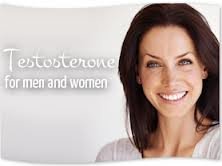
A number of studies show considerable proven and potential benefits for testosterone treatment in women.
Testosterone is widely and misleadingly understood to be the “male” hormone. Men produce 10 times more testosterone than women, but in their early reproductive years women have 10 times more testosterone than estrogen coursing through their bodies. And many experts now believe that it’s the loss of testosterone, and not estrogen, that causes women in midlife to tend to gain weight, feel fatigue and lose mental focus, bone density and muscle tone — as well as their libido. Testosterone is our most abundant biologically active hormone. Adequate levels of testosterone are necessary for physical and mental health in both sexes.
Benefits for Women
Women, before, during and past menopause, and sometimes as early as in their mid-30s, invariably have low testosterone levels,” Glaser says. Not all of them will experience its wide variety of symptoms, like low libido, hot flashes, fatigue, mental fogginess and weight gain. For those who do, and who seek to avoid taking synthetic oral hormones (shown by National Institutes of Health findings to pose an increased risk for breast cancer, heart attack, stroke, blood clots and dementia), bioidentical testosterone (whose molecular structure is the same as natural testosterone) has been shown to be safe and effective.
Some testosterone is converted by the body into estrogen — which partly explains why it is useful in treating menopausal symptoms. For those at high risk for breast cancer, or who have had it, that conversion can be prevented by combining testosterone with anastrozole — an aromatase inhibitor that prevents conversion to estrogen. Nonetheless, testosterone has been shown to beneficial for patients with breast cancer. Preliminary data presented at the American Society of Clinical Oncology have shown that, in combination with anastrozole, testosterone was effective in treating symptoms of hormone deficiency in breast cancer survivors, without an increased risk of blood clots, strokes or other side effects of the more widely used oral estrogen-receptor modulators tamoxifen and raloxifene.
With a growing recognition of testosterone’s benefits for women, those numbers may increase, but it may still be a while before the therapy reaches the mainstream. Advocates say that the very idea requires a rethinking of long-held notions about hormones. And many women have a knee-jerk suspicion that any hormone treatment can increase their risk of breast cancer. However, clinical studies show that testosterone not only does not increase a woman’s risk of breast cancer, it may play a key role in warding off the disease.
This information is brought to you courtesy of Dr. Mark Bishara and The Paragon Plastic Surgery & Med Spa in Mansfield and Southlake, TX
 .
.












